This is the second article of the cycle. Start here.
Today in Russia the 13th Guards Rifle Division is the symbol of street fighting in Stalingrad. However, the real events of those days have changed over time on the pages of historical and literary works. As a result, the true story imperceptibly faded into the background, giving way to beautiful legends.
In the battles near Kharkov and the Don in May-July 1942, the 13th Guards Rifle Division (GRD) suffered heavy losses. Now it was replenished with soldiers and NCOs, while among the commanders there were many yesterday’s cadets. A significant part of the Red Army was called up from the republics of Transcaucasia and Central Asia and had poor command of Russian language. The training of these recruits was extremely basic: two weeks in tactics and only one in shooting. There was an acute shortage of materiel.
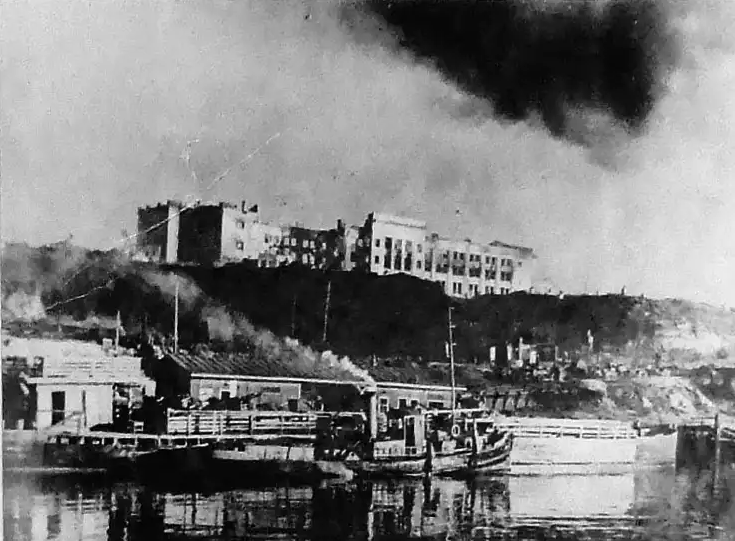
But the backbone of the division consisted in the paratroopers of the 5th Airborne Brigade, that benefited from the experience of fierce battles in the summer of 1942. The division was commanded by Major-General Alexander Ilyich Rodimtsev’s, a seasoned soldier who devoted his life to service and had two wars behind him: the Soviet-Finnish and the Spanish Civil War. His biography, like many of his peers who genuinely loved the motherland and communist ideals, in many ways resembled the lines of the famous Grenada poem of the 1920s by M. Svetlov.
On the evening of September 14, the 13th Guards Rifle Division concentrated in the area of the Krasnaya Sloboda, after having been urgently transferred to the area of Central Akhtuba the day before. It now faced a river and a city where it had to fight and win, because there was no other way out.
The division commander was thinking about this and much more, standing on the eastern bank of the Volga. There the half-tracks were delivering ammunition and food, which was stocked up by the soldiers and loaded onto boats and barges. The opposite side of the river, glowing with fires, showed skeletons of high-rise buildings. Explosions were visible on the shore and the sound of machine gun fire could be heard, which meant the Germans were already in the city and had reached the Volga.
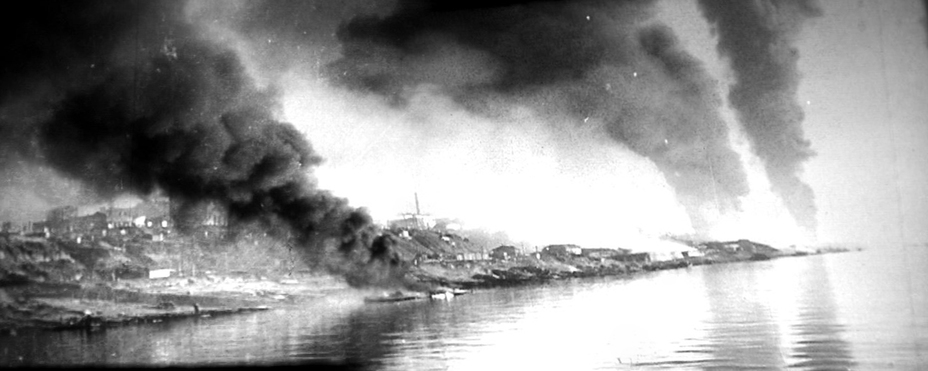
Towards midnight, the 42nd Guards Regiment of Colonel I.P. Elin began to cross. The first battalion of this regiment, reinforced by a company of machine gunners and several detachments of 45 mm guns, had already landed on the right bank with the task of clearing the crossing area from the Germans, thus securing a foothold on the bridgehead. But contrary to commander Rodimtsev’s order, the guardsmen of the first battalion, passing the «houses of specialists» occupied by the Germans from the south, under cover of the steep bank, began to advance further into the city center.
This battalion became the notorious «last battalion» that turned out to have received direct orders from Chuikov. Breaking the chain of subordination, the commander put the battalion commander Z.P. Chervyakov new objectives: to recapture the central station of Stalingrad and take up a circular defense there. The station area was the key to the defense of the city center, the wide space of the railway tracks and the broad Communist Street made it possible to look far ahead and all around.
During the night from September 14 to 15, following the units of the 42nd Guards Regiment, the 34th Guards Regiment under the command of Lieutenant Colonel D.I. Panikhin crossed over. When crossing a boat with fighters was hit by a shell, 12 men were killed. The motorist of another boat refused to lead the barge to the shore and was shot. At 10:00, when it was already dawn, the division headquarters and the commander were the last to cross. On its way, the armored boat came under German machine gun fire from the captured building of the State Bank, and a division engineer was wounded.
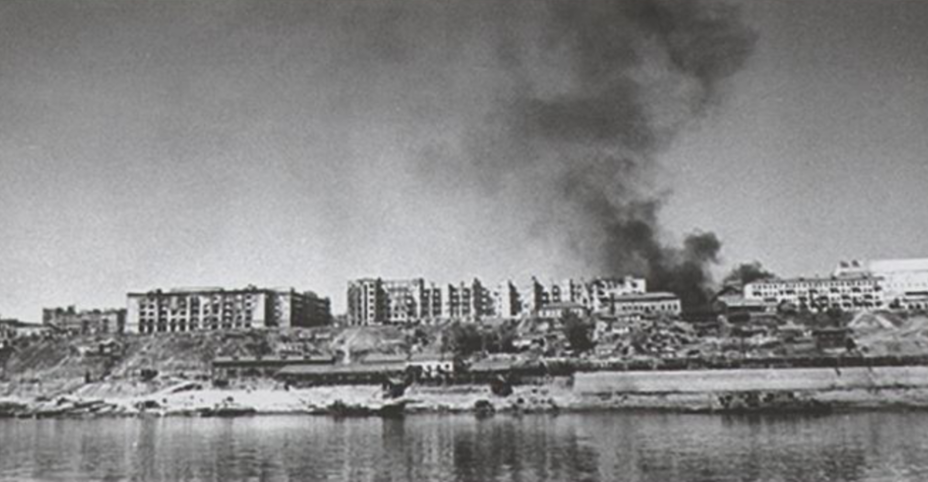
From morning to evening on September 15, German aviation intensively bombed the Volga embankment and the crossing area of the 62nd Army. The headquarters and the rear areas of the division literally buried themselves in the steep river bank, explosions and screams were heard all around, mutilated corpses were lying everywhere. In the afternoon, the division commander Rodimtsev was summoned by the commander Chuikov, whose headquarters were still located in the dugout on Pushkin Street. By rushing from one funnel to another, under constant fire, past the captured coastal buildings the divisional commander finally reached the army headquarters. Of the five commanders accompanying Rodimtsev, only two reached Pushkin Street. Chuikov’s order was clear: to advance. And Rodimtsev understood this very well. If you take up defense on a small coastal patch of land, the division becomes a sitting duck.
Returning to his dugout, Rodimtsev listened to the report of Colonel T.V. Belsky. The division’s units plunged deeper into city blocks under enemy fire. The first battalion of the 42nd Guards Rifle Regiment (GRR) took up defense positions at night in the area of the central station, messengers reported that in the battle for the station building the battalion commander was severely wounded.
The guardsmen of the 2nd and 3rd battalions of the 42nd GRR, having crossed over in the dark and immediately gone into fighting, had cleared by morning the sectors of the brewery and the NKVD buildings complex. The second battalion, outflanking the area of the State Bank, began to advance in the direction of the central station. A battle ensued at the four-story school No. 19, located behind the State Bank. A German machine-gun crew firing from the front window of the building prevented further advance. The third battalion was advancing along Solnechnaya Street heading for the railway, but the fire from the buildings of the Voentorg and school No. 6 pressed the soldiers to the ground.
The coastal «skyscrapers» on the flanks of the division were held by the Germans. The grenadiers of the 194th Regiment, 71st Infantry Division, had barricaded all the entrances to the State Bank building. At the «houses of specialists," inaccessible to the Soviet artillery from over the Volga, stood the Stugs of the 244th mobile artillery division. Rodimtsev decided to secure this area with a machine-gun battalion under the command of A.D. Kharitonov and a divisional security detachment. The remaining units of the 42nd and 34nd Regiments were tasked to advance in the direction of the railway, cutting off the Germans breaking through to the Volga.
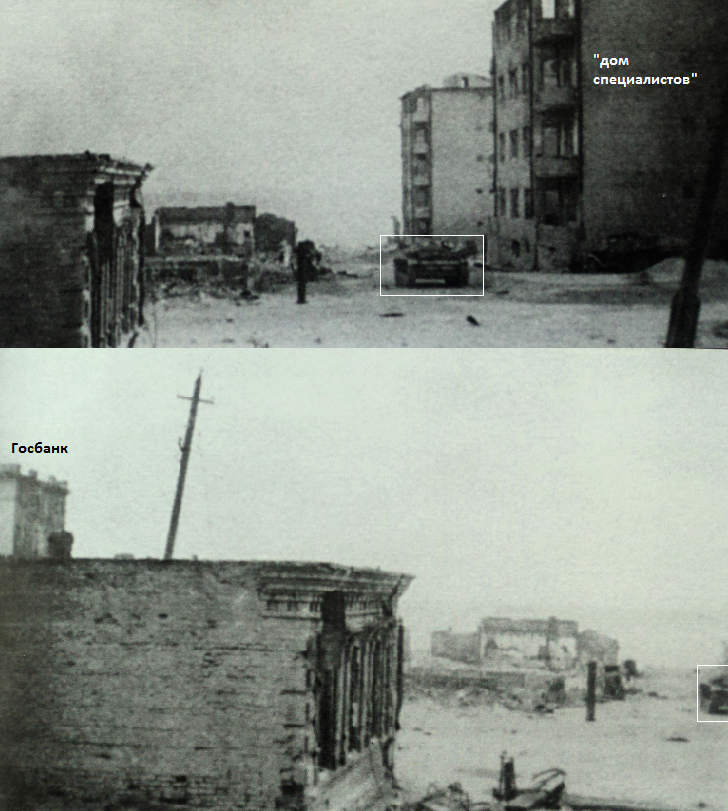
The 34th Guards Regiment of Panikhin, having landed in the area of the Salt Pier and the ravines Dolgy and Krutoy, met resistance from the reconnaissance detachment of the 295th Infantry Division in the area of the «L-shaped house» and «house of the railway workers». Having passed the buildings from the side of the ravine, the fighters of the second battalion, under cover of a smoke screen, expelled the Germans from the building. The first battalion continued to advance further along the ravine and went out to the railway.
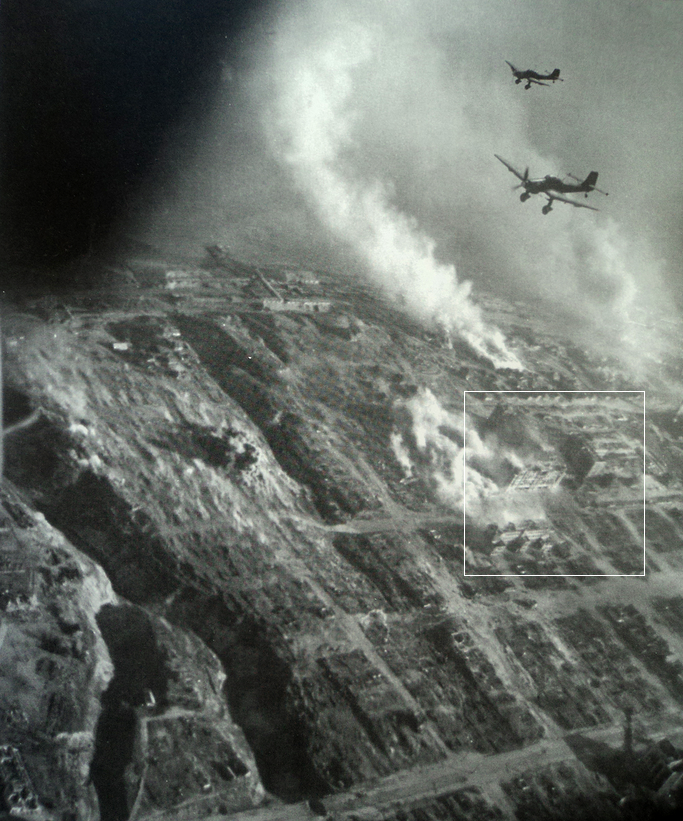
To the north, a fierce battle was fought on the top of the Mamaev Kurgan. The Germans pushed back the remnants of Captain Aseev’s consolidated regiment from the water tanks area, recapturing Height 102.
On September 16, the 39th Guards Regiment under the command of Major S.S. Dolgov, was operationally subordinated to Commander Chuikov. The regiment received the objective to drive the Germans out of the water tanks area and clear Mamaev Kurgan. The fighters of the first and second battalions launched a chain attack on the northern and eastern slopes of the mound. The third battalion came under German air raids as it approached the frontline, was dispersed and suffered heavy losses.
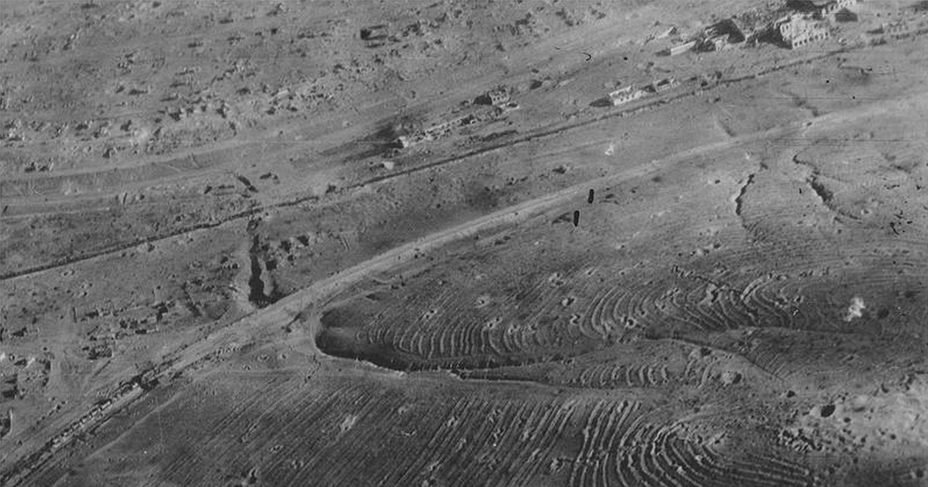
The closer to the top the denser the enemy’s fire became, the German machine guns on the flanks did not allow the soldiers to raise their heads. They lay down and moved back, the company commander was killed. Another shot, and a German machine gunner, twitching, crashed to the bottom of the trench. The second crewman, recklessly trying to remove the “MG” from the parapet, fell down beside him. Thus, the future famous sniper of the 13th Guards Division, Anatoly Ivanovich Chekhov, opened his count.
The commander of the second battalion, the twenty-seven-year-old captain Matvey Danilovich Kirin, led the way raising the lying soldiers to the attack. At the top of the mound, in trenches and dugouts, the guardsmen of the 39th Guards Regiment and the infantrymen of the 517th Regiment were shooting at each other at point blank range. As it came to cold weapons, the Germans withdrew, unable to withstand the bayonet strike. At 13:00 on September 16, Height 102 was back in Soviet hands. In the sixth company, which took up positions around the right water tank and was preparing for all-round defense, eighteen remained out of a hundred and twenty fighters. Hearing the noise of tank engines from the western side of the mound, Kirin thought gloomily about the six PTR left in the battalion.
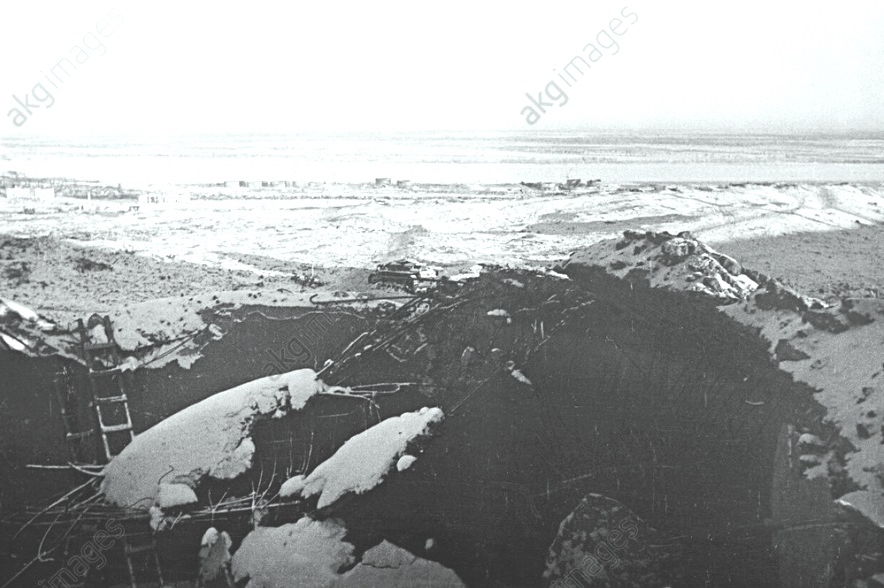
At 24:00 on September 16, the headquarters of the 62nd Army were evacuated from the city center to the embankment behind the Barricades and the Red October Factories. First they had to cross to the eastern bank, because the German positions in the «houses of specialists» and the State Bank kept the shore under fire. But the Germans themselves (the battalion of Hauptman Hindelang), were fighting in encirclement. The forward units of the 42nd and 34th Guards Regiments of the Rodimtsev division had reached the railway line and the wide Communist Street. The first battalion of the 42nd Guards was able to gain a foothold in the Central Station area, cutting off with their fire the supply routes of the German units that reached the Volga.
The next day, September 17, the combined regiment of 112 Rifle Division and 39 Guards Regiment were ordered by the Army commander to launch an offensive along the southwestern slopes of Mamaev Kurgan towards the city center and the railway line. But the omnipresent aircraft in the sky and German firing points in buildings at the foot of the mound made the offensive impossible, as the regiments suffered heavy losses. From the area of the Red October Factory, three marine 152 mm guns mounted on railway tracks fired on the accumulation of German infantry and materiel on the western slopes of the Mamaev Kurgan.
To the south of the mound, in the center of Stalingrad, there was a moment of relative quietness. Cut off in the buildings on the embankment, the advanced Germans detachments were forced to save their ammunition, but Rodimtsev’s division also began to lack its. The situation was aggravated by the explosion of shells stored on the banks of the Volga, that detonated from a German direct hit.
In the areas of the landing stages the crowding did not decrease: despite the reports of 71st Infantry Division, ferries No. 1 and 2 were still working. Boxes with shells quickly unloaded from the arriving armored boats, and a few replenishment soldiers jumped into the water. The wounded and civilians were dragged back. As the situation was about to degenerate into a confused stampede, a few workers of the NKVD and the security detachment of the 13th Guards tried to put things in order, using obscenities and holding out their Nagan pistols. Unattended killed soldiers lay around, funnels gaped and railway wagons piled up. The constant artillery and aircraft bombing only supplemented the picture of the Stalingrad apocalypse.
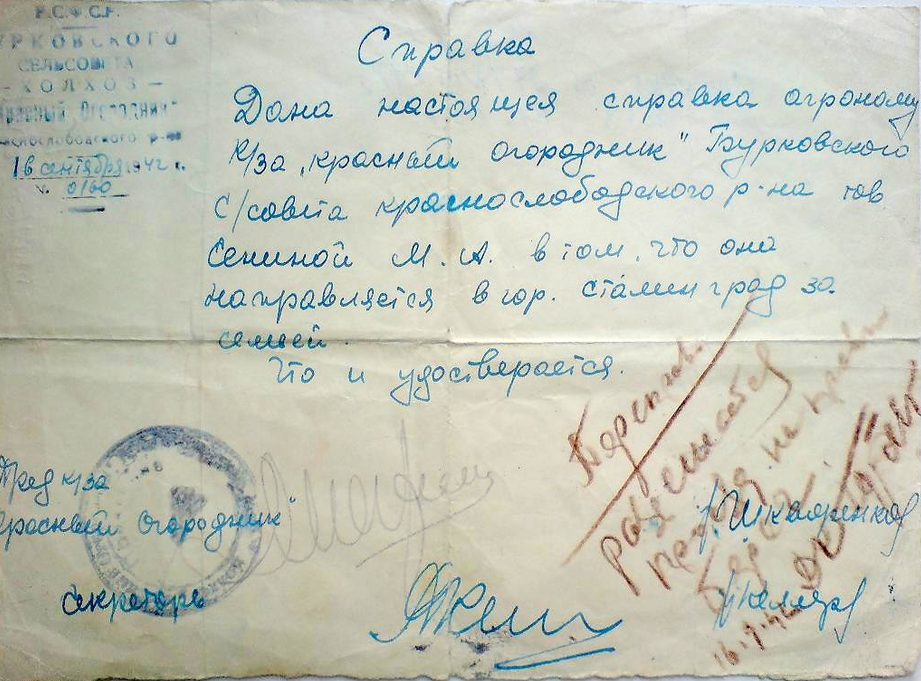
On the night of September 17-18, 137th Tank Brigade, along with two battalions of 92nd Naval Rifle Brigade, crossed the river to the city.
The 92nd Rifle Brigade, consisting of four battalions, crossed into the city near the monument to Kholzunov and was to take up the defense south of the Tsaritsa River, where the remnants of Soviet units were fighting in near encirclement around the huge building of the Grain Elevator, which already changed hands twice.
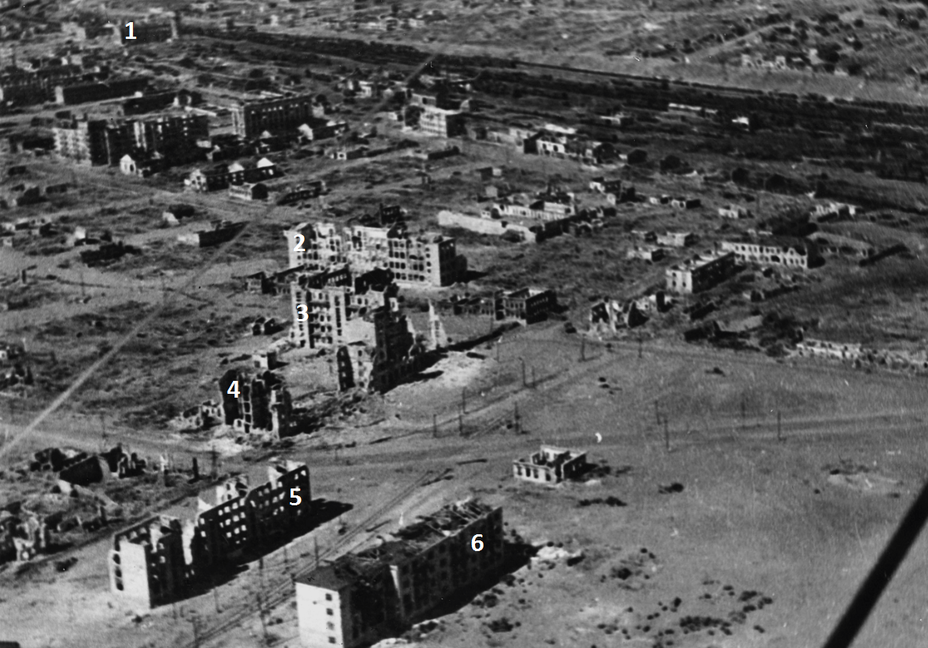
1. In the distance looms the central station of Stalingrad, where the 1st Battalion of 42 GRR held positions
2. Building of School number 6
3. Ruins of the six-story building of Oblpishcheprom, better known as the Voentorg
4. Remains of the adjacent «house of metalworkers»
5. House of Sovpartkontrol, known in the divisional reports as «Zabolotny’s House»
6. House of Oblpotrebsoyuz, better known as «Pavlov's House»
At night, Chuikov was ordered by the Front Command to go to the offensive: «… in order to assist the troops of the Stalingrad front and clear the city of the enemy: use the forces of three rifle and one tank divisions of the 62nd Army to attack from the area of Height 102 in the north-western direction and to the western suburbs of the city of Stalingrad.”
In 137th «tank brigade», there were only 10 light T-60 tanks. On September 19, its tankmen were used like ordinary infantry: at 12:00 two battalions of 250 people each launched an attack on the northern slopes of Mamaev Kurgan in the direction of Height 112.5 and the Flying School. The fresh 95th Rifle Division also took part in the offensive on September 19th with two of its regiments that managed to cross over by the evening of September 18th. They were assisted by the remnants of 9th Motorized Rifle Brigade. German artillery and six-barreled mortars covered the height with one volley: the attack failed, and heavy losses added to the already bloodless 62nd Army.
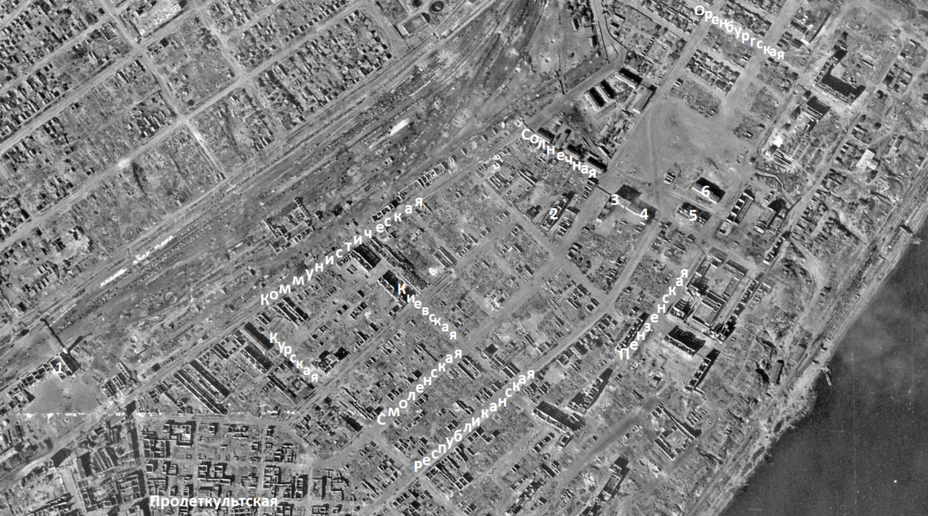
In the center of the city intense struggle went on for every house, skirmishes and hand-to-hand fights broke out here and there. In the area of the Ninth January Square, the front line ran along the main wall of the building separating the six-story Voentorg and the four-story «house of metalworkers." At night fighters of the 7th Company, 3rd Battalion, 42nd Guards Regiment managed to recapture the «house of metalworkers», then after destroying a German barricade in the corridor, they kicked out the Germans from the Voentorg building. Since the squad leader was killed in battle, Sergeant Yakov Pavlov took responsibility for the task.
On September 18, guards from the 9th Company stormed the four-story building of school number 6 on the Smolensk Street opposite the «Voentorg», but failed to completely capture the school in the afternoon. At night Sergeant Makarov Lazar Grigoryevich made his way into the wing of the building occupied by the enemy. After making sure that the Germans were sleeping, the guards sergeant and two fighters with knives finished off the remnants of the German garrison. Sergeant Makarov did not know then, that in two months he would once again storm the ruins of school No. 6 as a lieutenant, and the actions of his group would be depicted in military records and in the central newspaper Pravda.
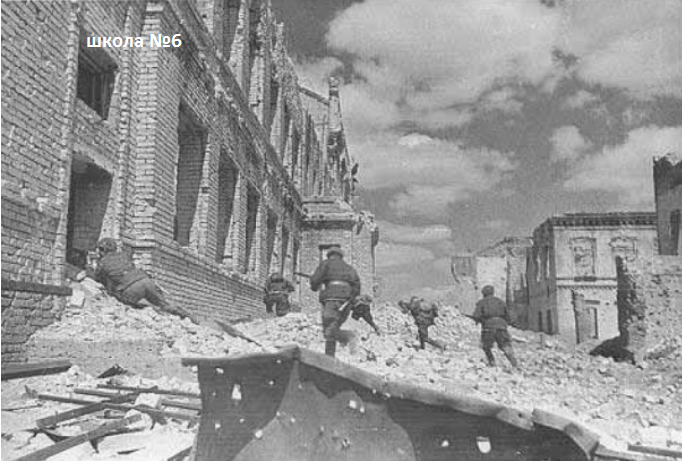
The platoon of Lieutenant Nikolai Zabolotny went along Solnechnaya Street to the railway, the twenty-two-year-old platoon commander leading the way. At this time, the soldiers of the 3rd Battalion were clearing buildings on Solnechnaya Street. Guards Lieutenant Zabolotny, drafted into the Red Army only a few months ago, will be killed on November 24 on Ninth January Square.

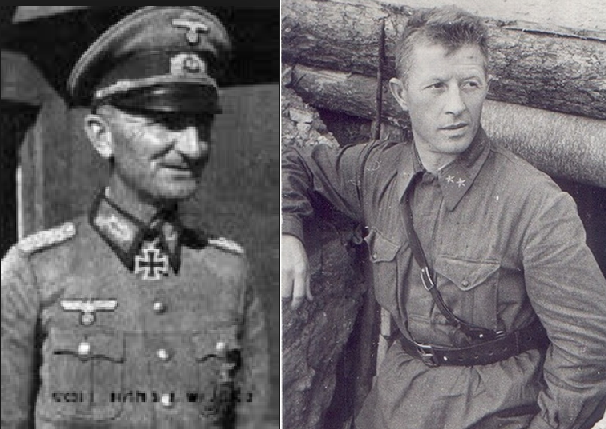
On the right is Major General Alexander Ilyich Rodimtsev, commander of the 13th Guards Division, 37 years old. He took part in the civil war in Spain (where he received the title of Hero of the Soviet Union, the Order of Lenin and two orders of the Red Banner) and the Soviet-Finnish war. The soldiers of the 13th Guards Division, formed from an airborne corps, met for the first time the infantrymen of Hartmann while defending Kiev. Their next «encounter» was near Kharkov, and now — in the center of Stalingrad
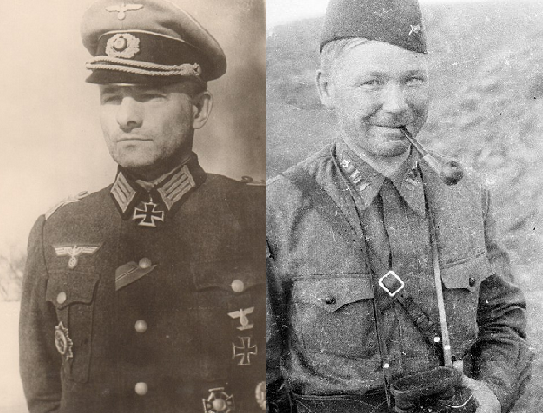
Right, the commander of the 42nd Guards Regiment, 13th Guards Division Colonel Ivan Pavlovich Elin
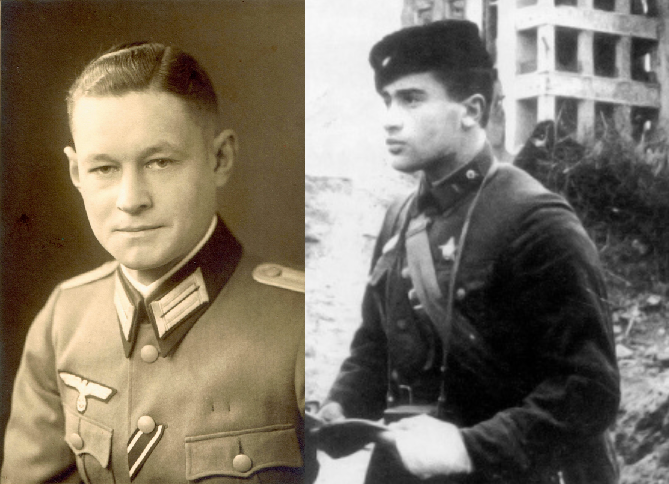
On September 19, at 12:00, as already mentioned above, the offensive of 62 Army began. Rodimtsev’s division had the former task of clearing the city center from the Germans. Three KV-1s (all that remained of 133rd TBR) were assigned to help the battalions of the 42nd Guards Regiment. The tanks first fought off German attacks in the vicinity of the station, then they fired at separate buildings captured by the Germans on the Communist and Smolensk Streets, supporting the soldiers of the second and third battalions. In the afternoon, the vehicles left for the area north of Ninth January Square, «where an attack of the 295th Infantry Division was expected along the Dolgy ravine and assault guns were spotted”.
As soon as it went dark, sappers of the 13th GRD crawled to the northern wall of the State Bank captured by the Germans, pushing several boxes of metal sheets in front of them. The sapper platoon of Lieutenant Ivan Chumakov was covered by submachine gunners of the division’s security detachment. The Germans did not open fire, their firing points were located in the back of the building, and each one was counted. Having regrouped for attack in the craters near the State Bank, the Soviet soldiers were waiting for the explosion, but the incendiary tube burned for a painfully long time. Chumakov squeezed the handle of the backup detonator, and the next moment there was a flash, while the roar of the explosion pressed him to the bottom of the trench. Fighters running up to the building were already throwing grenades and Molotov cocktails into the windows of the second floor, and an assault group disappeared in the wall breach. During the night, soldiers of the detachment and reconnaissance divisions cleared the northern wing from the shell-shocked Germans, but their opponents still held the southern part of the building. By the morning, the front line divided the ruins of the State Bank in half.

On September 20, the commander of the 6th Army, Friedrich Paulus, began to lose patience. The assault on Stalingrad lasted a week. But, despite the tons of ammunition spent, the complete dominance of the Luftwaffe in the air and the columns of prisoners, the city was still not captured. 295th and 71st Infantry Divisions, which reached the Volga on the second day of the assault, were bogged down in street fighting in the city center, and there were not enough men in their battalions.
To the south of Tsaritsa River the situation was much better: 24th and 14th Panzer, 94th Infantry and 29th Motorized Divisions finally broke the resistance of the Russians in this area. The fall of the surrounded Russian fortress, the huge elevator building, was a matter of several hours. Soldiers of 94th PD had already captured the strategically important railway bridge across the Tsaritsa and established communications with 211th Regiment of 71st Division. 24th PD was deployed to the north with the task of supporting 295th assault groups in the Mamaev Kurgan area: on that day, the division had 22 tanks and 2 armored personnel carriers on the move. 71st ID regiments, together with one regiment of 94th ID, continued to clear the center of the city and the bed of the Tsaritsa, supported by assault guns of 244th and 245th Sturmgeschutz divisions.

Having taken command of the 62nd Army a little more than a week ago, Lieutenant-General Chuikov had something to worry about. The army was cut off from the rest of the front forces, to the north in the vicinity of the village of Rynok, and to the south near Kuporosnoe. The supply of troops was carried out through the Volga, under fire from German strongpoints near the landing stages, and the front of the army was split up. On the left flank, four German divisions were finishing off the remnants of the 35th Guards Division and its attached units around the Elevator: the naval infantry of 92nd Brigade was only able to delay the collapse of the defense in the Voroshilovsky District of Stalingrad for about four days. The Germans reached the Volga in the center of the city, the Rodimtsev division was bloodless and could hardly hold the crossings. Half of Stalingrad was lost and the main task of commander Chuikov was clear: to hold Height 102 (Mamaev Kurgan).
But the Front command insisted on continuing the offensive. On September 21, the scarce infantry of the 95th RD and tankmen from 137 TBR again went on the attack under heavy artillery and mortar fire. Then German aircraft appeared in the sky and began to bomb Mamaev Kurgan, the streets of city center and the banks of the Volga. At 12:30, the headquarters lost contact with the southern group and Chuikov lost control of the left flank of the army.
The forces of 13th Guards Division were running out, in terms of «active bayonets» numbers, regiments equaled battalions. In 42nd GRR there was one battalion left out of three. The division was pressed up against the Volga, the command post was located counted meters from the German positions. There were fire exchanges all over the frontline, 51st Army Corps noticeably increased artillery shelling and did not spare its ammunition. There was no connection with the 1st Battalion, which defended in the area of the Central Station. The Kiev and Kursk Streets were once again under German control. The ruins of the State Bank were recaptured in the afternoon by subunits of 71st ID and the Germans became the new left «neighbor» of the Rodimtsev division.
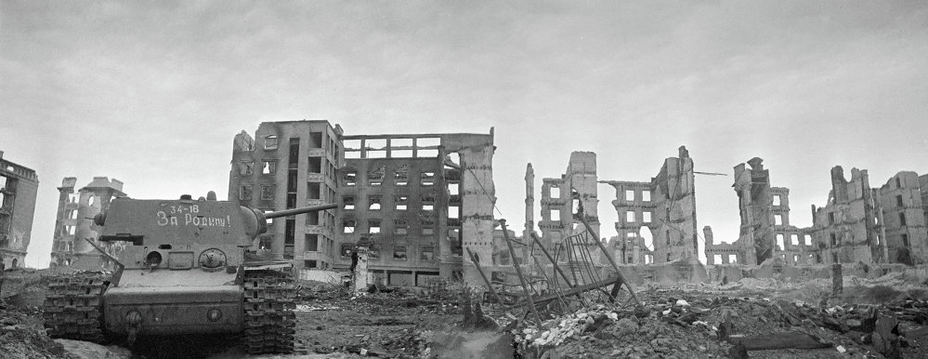
In the dark, a barge with 690 men reinforcements was brought to the landing stage. It was possible to distribute the fighters among their companies and fox holes, the night was surprisingly calm.
The silence of the morning was cut by the screech of the sirens of the «musicians», the Ju-87: September 22, 1942, the most difficult day in the history of the 13th Guards Division, began.
Nine dive bombers swirled over the blocks where Soviet soldiers were defending. High-rise buildings collapsed. Then artillery and mortars fired on previously acquired targets. At 7:00 in the morning, the Germans went on the attack all over the front in city center, from the ravines to the Tsaritsa River.
Replenished by penal companies, 295th ID supported by thirty assault guns fell upon Panikhin’s depleted 34th GRR. On the left flank of the regiment in the area of Ninth January Square, a battle ensued for school No. 6, defended by soldiers of the 9th Company of Captain Zhukov’s 3rd Battalion. From the windows of the four-story school, as from the nearby six-story Voentorg, the railway track and the one-story “Balkan” area were perfectly visible: gray figures were carefully moving along the streets and courtyards of the railway. Several self-propelled guns with mounted infantry quickly passed the railway tracks, and went on to Solnechnaya Street. Tracers of the «Maxims» light machine-guns stretched out from the Voentorg towards the ravines, and shots of PTR anti-tank rifles could be heard. The Stugs sent cumulative shells at the windows from where Soviet soldiers fired. The Wehrmacht infantrymen, having gathered in the backyard near school No. 6, attacked the building and hand-to-hand fighting erupted in the corridors and rooms. The last soldiers of the 9th Company fought back until darkness in the burning ruins. At night the Germans occupied the school and Voentorg. 9th Company’s commander, Lieutenant Vasily Babenko, was seriously injured but miraculously survived. He perished two years later.
The “Balkans” were burning, courtyards and streets in this sector were clouded with smoke. Near the L-shaped House stood the camouflaged “forty-five” 45-mm guns of the 4th tank destroyer battalion of the 13th GRD, as the spotters located on the sixth floor counted the low-profile German tanks crawling out of the ravine. One after another, the gun crews entered the fighting, while the Stugs fired back. Shells flew towards the firing positions, the German infantry was already a few hundred meters from the Russian trenches.
The Junkers hovered over the L-shaped House, diving at their targets with a roar. Along the wide Orenburg street, several Stugs and APCs were burning down. Gunner Leonid Ivanovich Lyubavin was standing at the sight of one of the “forty-fives”, the loader was killed, and the orderlies were carrying away the wounded commander. Lyubavin himself was injured, but he did not leave the gun. In the evening, when the detachment ceased to exist, the bleeding Red Army soldier Lyubavin was carried to the Volga shore. A year later, he will perish from another battle wound.
Some Germans broke through to the shore along the ravines, where the headquarters of the 34th GRR was located. Headquarters staff, clerks, medics, all were in the trenches where German grenades were already flying in from the ravines. The headquarters was surrounded, there was no connection with commander Rodimtsev, according to the report only 48 «active bayonets» remained in the regiment.
In the afternoon, the strike group of 71 ID, up to two infantry companies and fifteen Stugs, advanced from the State Bank area towards Ninth January Square, to the positions of 42 and 39 GRRs. At 16:00, the dust barely settled down after the artillery preparation as the self-propelled guns appeared on Penzenskaya Street. Behind them, covering themselves with the armored vehicles and running from funnel to funnel, the German infantrymen carefully progressed. The surviving guardsmen, getting out of shelters and dugouts, hastily occupied their positions, some rifle shots were already heard from the ruins of the brewery. The Stugs stubbornly crawled forward, firing at the ruined buildings.
Suddenly, bullets hit the armor of the first assault gun, and the infantry swept behind in search of shelter. Another burst, and those Germans who had no time to jump fell like bags from the last vehicle. The cries of the wounded were drowned out by the roar of the engines, the officers searched in vain for the Russian firing point in the ruins. One of the Stugs, breaking away from the infantry, drove too close to the dilapidated fence of the brewery, from where bottles of incendiaries flew right away. The Stug pulled over, enveloped in fire.

The machine-gun crew of the 7th Company consisting of Pavel Demchenko, Pavel Dovzhenko and the replenishment newcomers held positions in the destroyed «Zabolotny's house». Demchenko was lying behind a machine gun, Dovzhenko sat down next to him, in the corner one of the newcomers was loading tapes with cartridges. The Germans attacked stubbornly, the streets were drowned in dust from explosions, but the experienced machine gunner Demchenko fired on previously studied landmarks. In the summer of 1942, Pavel had to abandon his native Ukraine to the invaders, his family remained near Kharkov and he desperately needed to return.
Two Stugs appeared at the intersection of Republican and Nizhny Novgorod Streets, turned in the direction of school No. 6 and opened fire on the upper floors. From the side of the NKVD complex, shots of anti-tank rifles were heard: one of the self-propelled guns suddenly jerked and flames crawled along the armor. Tankmen climbed out of the open hatches, the next vehicle backed away. “Pay Aleksandrovsk and pay Kharkov…” shouted Red Army soldier Demchenko as he pulled the trigger.
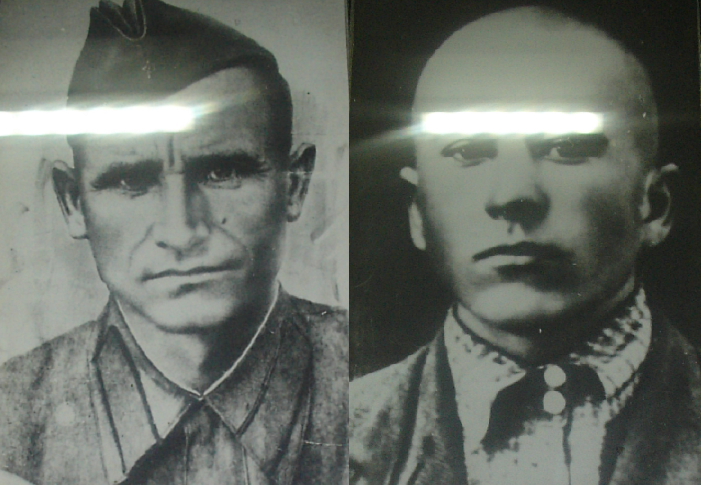
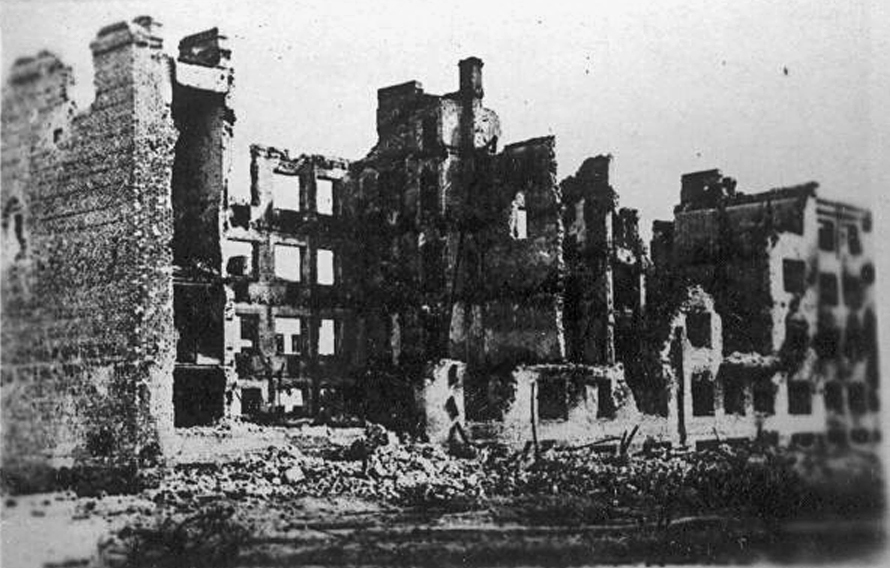
In the dugout behind the ruins of the NKVD complex, where the headquarters of the 13th Guards Division was located, there was intense action. In the morning, after artillery and mortar preparations, the Germans went on the offensive, while the Luftwaffe fiercely bombed the Volga. By noon, it became clear that the Germans were directing the main strike to the right flank of the division.
By 6:00 p.m., German soldiers from the 295th Infantry Division again seized the «L-shaped house» and the «House of the railwaymen», thereby virtually cutting off Rodimtsev’s division from the rest of 62nd Army. Several dozen men remained from the 34th Regiment, the guns of the 4th destroyer division were destroyed. To help the Headquarters of the regiment, surrounded at the mouth of the Dolgy ravine, the division’s commander Rodimtsev threw his last reserves: a combined battalion of rear service units and the reconnaissance detachment of the division. The guards were able to contain the Germans breaking through to the shore, the headquarters were freed and the right flank of the division was restored. The front line ran along 2nd Naberezhnaya Street, high-rise buildings several tens of meters tall stood along the steep bank, in which German infantrymen were already entrenched. The fate of the division literally hung «in the balance», it was connected with the rest of the army by a narrow strip of the Volga coast.
The sector of Ninth January Square was at the mercy of the Germans, the buildings of school No. 6 and the Voyentorg were seized. The Germans destroyed the Zabolotny House from artillery and self-propelled guns. On Solnechnaya Street, passing the square, two Stugs drove straight to the Volga. The infantry marched behind them, but machine-gun fire from Mill No. 4 and a volley of rockets from under the steep bank of the river forced the Germans to withdraw. Without infantry support, the self-propelled guns hesitated and then turned back.
With the onset of darkness, the battle began to subside, the Germans were consolidating in positions captured during the day. The 13th Guards Division counted its surviving fighters, materiel and ammunition.
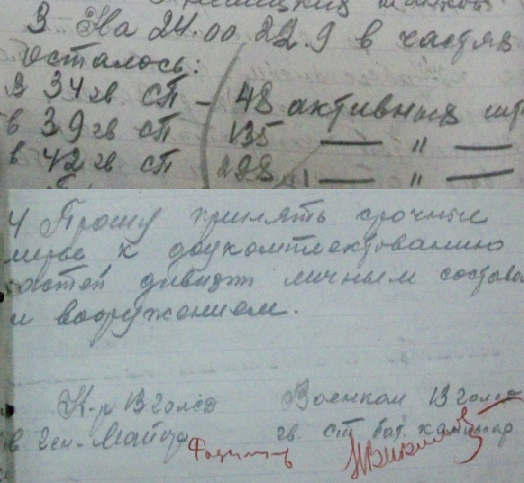
At night, the long-awaited reinforcements were sent to Rodimtsev: the full-strength 685th Rifle Regiment from the 193th Division of Major-General F.N. Smehotvorov. To the north of the Dolgy ravine, in the refinery area, landed sailors from the 284th Division of Colonel N.F. Batiuk and established the connection with the 34th Guards Regiment of Lieutenant-Colonel Panikhin. The 13th Guards Division survived, holding a small piece of the Volga coast and a few ruins in the city center.
On the same day, September 22, the Germans were finally able to capture the Elevator building. War correspondents were already working in the captured Voroshilovsky district and the center of Stalingrad, recording on film the Wehrmacht’s tired and dusty soldiers in the captured city blocks. The news about the capture of the Central Station and the district of «Party buildings» was forwarded by news agencies of the pro-German countries. It seemed that the city was about to fall.
But although without command, the last soldiers from 92 and 42 rifle brigades continued to hold the shore of the Volga and the mouth of the Tsaritsa for several days. And in the area of the central station and the Komsomol Garden, the surrounded headquarters of the first battalion, 42nd Guards Regiment and the 272nd NKVD Regiment would also fight back the Germans for a few more days.
The fight for Stalingrad was just beginning …
Below are the tables of losses in German 71st and 295th Divisions for the period of hostilities in the city center September 14-22. In the numerator are officers, in the denominator are soldiers. Data provided by Australian historian Jason D. Mark, special thanks to him.
71. Infanterie-Division
| 14.09.42 | 15.09.42 | 16.09.42 | 17.09.42 | 18.09.42 | 19.09.42 | 20.09.42 | 21.09.42 | 22.09.42 | |
| murdered | -/38 | 3/27 | 1/10 | -/25 | -/5 | 1/12 | -/10 | -/12 | -/10 |
| wounded | 6/120 | 1/102 | -/50 | -/57 | 3/40 | 3/60 | -/60 | -/45 | 3/40 |
| missing | -/1 | -/- | -/10 | -/- | -/- | -/- | -/- | -/- | -/- |
295. Infanterie-Division
| 14.09.42 | 15.09.42 | 16.09.42 | 17.09.42 | 18.09.42 | 19.09.42 | 20.09.42 | 21.09.42 | 22.09.42 | |
| murdered | 1/17 | -/20 | 1/38 | 1/26 | -/19 | 1/16 | -/22 | -/8 | -/46 |
| wounded | 7/157 | 9/116 | 7/123 | 3/99 | 1/68 | 1/78 | 2/77 | 1/45 | 7/164 |
| missing | -/1 | -/1 | -/9 | -/1 | -/1 | -/- | -/- | -/1 | -/4 |
13th Guards Rifle Division
| 14.09.42 | 15.09.42 | 16.09.42 | 17.09.42 | 18.09.42 | 19.09.42 | 20.09.42 | 21.09.42 | 22.09.42 | |
| murdered | 1/10 | 8/116 | 13/105 | 14/152 | 9/48 | 3/84 | 6/59 | 8/101 | 2/171 |
| missing | -/8 | 1/32 | -/17 | -/22 | 4/25 | -/56 | -/33 | 1/102 | 2/112 |
| died of wounds | -/- | -/1 | -/2 | -/2 | -/2 | -/1 | -/3 | -/4 | -/4 |
The table of losses of the 13th Guards Division for the same period was compiled according to the Memorial electronic database. Only irrecoverable losses were noted in the reports, i.e. it is necessary to additionally take into account the evacuated wounded, the number of which was often 2-3 times more than the killed. Even these scary numbers will be far from complete, because in the case of encirclement of the headquarters of a battalion or company, data on losses were usually lost. Most of the missing are fighters captured for various reasons. It should be said that shortly before the battles in Stalingrad the division suffered heavy losses. In August, the division was replenished, and by mid-September, a significant part of the personnel consisted of new conscripts, untrained soldiers who often came from distant corners of the country, and who had never been to the city. Ammunition quickly running out, a depleted command staff, a huge ruined city in which it was very difficult to navigate: all this should be taken into account.
Translated by Anton Joly.






